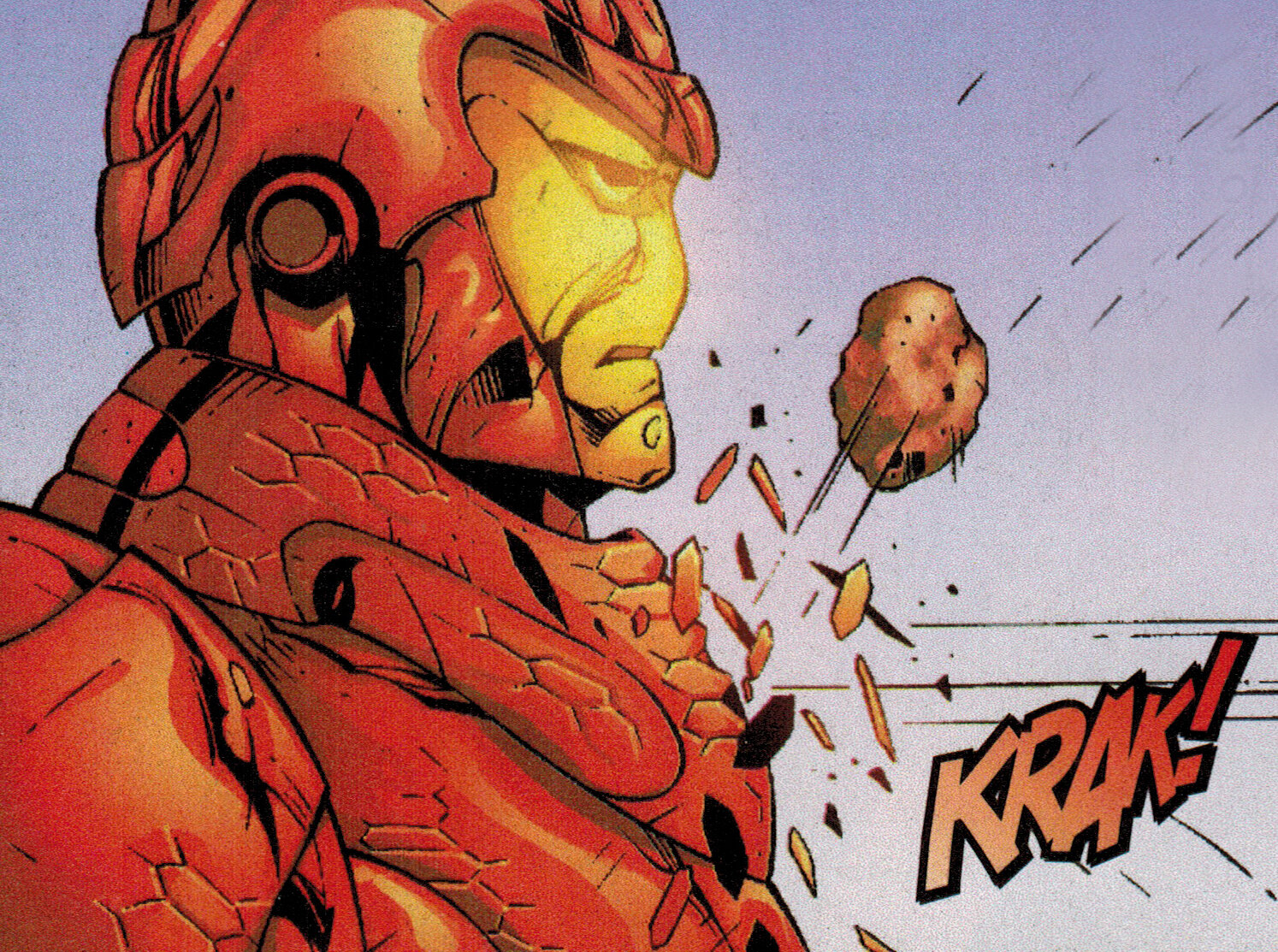How Axol Came To Be
Tin Man compromised
Tony is attacked by his Tin Man armor while staying in a Las Vegas hotel room. A parasitic alien goo has taken it over, forcing Tony to press the self-destruct button. He realizes that any standard armor he chooses will also be taken over as soon as it’s touched by the goo. His best bet is a new prototype armor designed for outer space, one that can shed its skin whenever the parasite attacks.
The Ablative Armor Mark 1 (Model 23)
Axol was created as an outer space suit to deal with the hazards Tony might encounter in asteroid fields, comet tails, and particle storms. The armor’s exterior is made from hundreds of tessellated hexagonal elongated rhombus high-impact polymer tiles, each about 3-inches long and an inch high. When a tile is damaged, it pops off and is replaced by the next underlying tile. While not specifically said in the comic, I theorize that there are four layers of tiles before the gray inner skin of the armor is reached.
The lowermost tile might never be needed, however, thanks to the kiln on the back of the armor. This kiln cooks new polymer tiles and drops them from four ports, where the tiles are picked up by the forcefield and put back into place. These two methods of repair makes the armor self-healing from the inside-out and the outside-in.
The forcefield can also grab extra tiles and use them as chaff to create a shield against incoming projectiles. For extraterrestrial exploration purposes, the tiles could create a barrier to protect against space debris while the wearer performs a scientific experiment. In battle, the tiles could detonate a warhead at a distance. There’s no reason the semi-sharp tiles couldn’t be used for offensive purposes as well, acting as shuriken or forming the shape of a sword.
Armament
Since there is an airtight (and space-worthy) Iron Man skin under all of those tiles, Axol had the standard armaments and systems of a basic Iron Man armor. This includes repulsors, a chest beam, scanning abilities, and enhanced strength. Each index fingertip has a diamond-edged blade for extracting samples from asteroids and comets. A complete list of the Ablative Suit’s abilities can be found here.
Theories On Design
When an armor is made from hundreds of polymer tiles, it can’t help but look different from previous incarnations. While Axol kept the red and gold color scheme of a typical Iron Man armor, the matte finish of the tiles certainly set it apart. The armor was also designed with more flowing lines; this balances the straight lines of every tile. Parts of it can best be described as bulbous, with the hard shell looking almost crablike.
The Helmet Ridge - Since Tony created the armor for use in space, the helmet ridge most likely houses long-range communication equipment. The extra equipment might be necessary to boost a signal through an iron-rich asteroid or reduce interference caused by a comet tail .
The Large Boots - Most Iron Man armors are designed to work in atmosphere, which is why Tony started making specialized space armor as early as issue #142 (January 1981). Replusors work differently in space, which is why the boots need the additional size to accommodate the components for use in space and on a planet with an atmosphere.
The Oversized Gauntlets - Like the boots, the gauntlets may need additional tech to optimize them for outer space. Also, notice that the gauntlets have ablative tiles and the faceplate does not. The large gauntlets could help cover the faceplate in an emergency situation when the chaff tiles can’t be deployed quickly enough.
The Codpiece - When you’re in space and tiny particles are hurling at you at thousands of miles an hour, you want extra protection. (I have two humorous blogs about codpieces up, and you can check them out here and here.)
For additional information about the design of the Ablation Suit, click here.
Ablation Explained
In simplest terms, ablation involves parts that break away/wear away so that impact energy/heat isn’t transferred to the main body. The most well-known real-world application are ablative heat shields that protect space vehicles upon atmospheric reentry.
For its intended purpose as an outer space exploration armor, the armor tiles break and dissipate the impact energy from meteoroids and comet tail debris. If it were solid like a normal Iron Man suit, every meteoroid could cause a dent in the armor once the suit’s energy shield was depleted. In space, these impacts would be extra difficult to deal with, since every hit would send Iron Man spinning in circles and cause the wearer to reorient constantly. Since the tiles of Axol are helping remove the impact energy from the suit, reorienting is much less of an ordeal.
While not technically ablative, similar ideas are at play in consumer vehicles. Crumple zones are parts of a vehicle that are designed to compress during a crash, absorbing some of the impact energy instead of transferring that energy to the vehicle’s occupants. Formula 1 race cars will also break apart when hit, taking the crash energy with each piece while the driver stays safe in the rigid safety cell.
Ablative armor is different from reactive armor found on tanks. Reactive tank armor creates an explosion to detonate an incoming projectile before it reaches the tank’s hull. Ablative armor actually takes the energy of the impact with it as it breaks apart.



